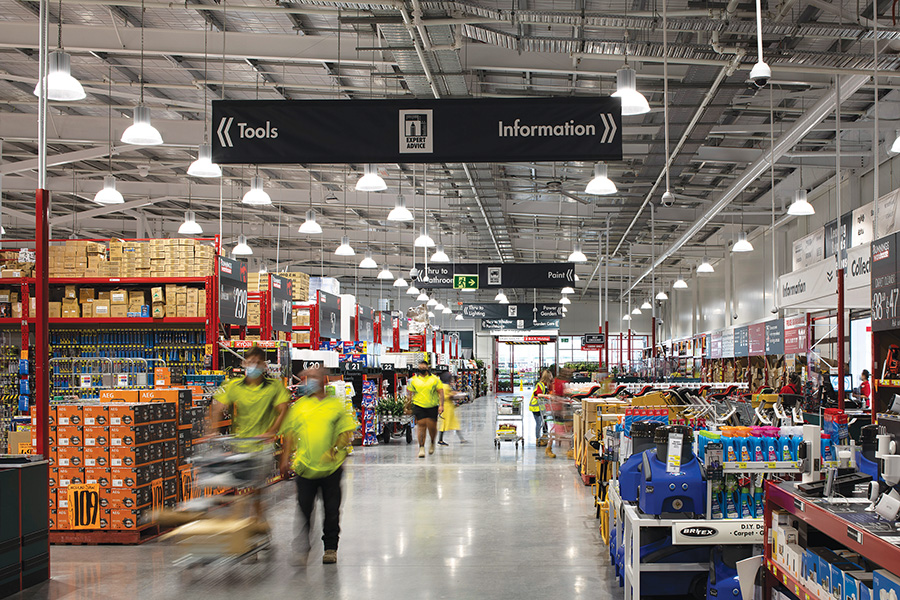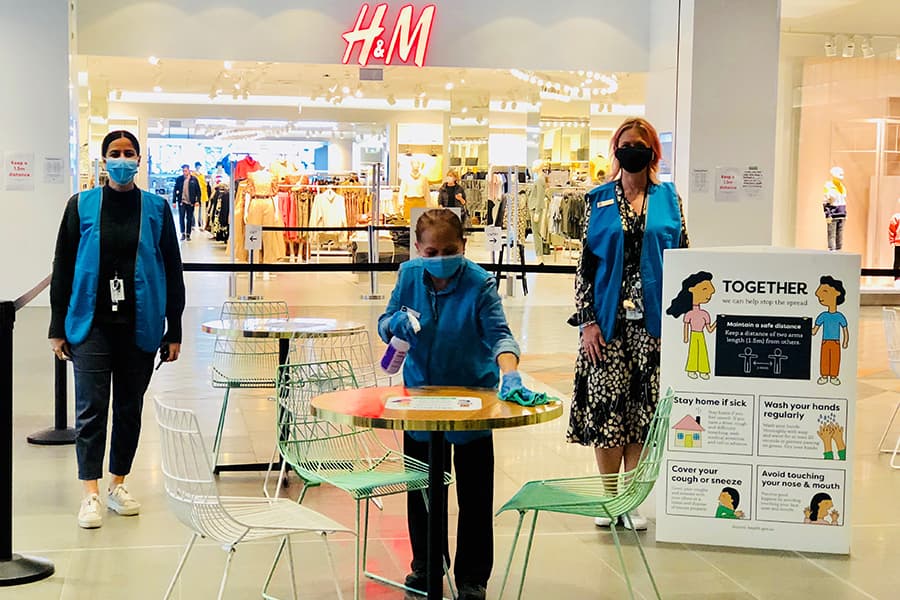Everyone wants to get involved in China. It’s understandable: almost a quarter of Earth’s population coming on stream and approaching middle class, is a phenomenon too significant to ignore. But how do you get involved? Michael Lloyd, SCN‘s publisher and Milton Cockburn, former Executive Director of the Shopping Centre Council of Australia are working on it!
Some years ago, Frank Lowy, the co-founder of Westfield, was asked why the company had not yet entered the developing shopping centre industry in China. He replied that investing in China was a matter constantly under review within Westfield but that the company felt that the conditions were not yet right to make such an investment.
Mr Lowy acknowledged that, if the company decided to diversify into China, Westfield would probably pay a higher entry price but that the risks of any investment would be much less than appeared to be the case at that time.
More than a decade later, and despite the impressive growth of the Chinese industry during that decade, this remains the view of most Australian shopping centre investors, not just Westfield Corporation. Even though some foreign companies have made the plunge in China – most notably the Singapore-based CapitaLand – the Australian caution is justified.
The reason for this caution is the paradox at the heart of the Chinese industry. On the one hand, China remains undersupplied with retail space when measured on a per capita basis. On the other hand, it is likely that the vast majority of existing shopping centres are either not profitable or are only just meeting their operating expenses.
Despite the rapid growth in China’s shopping centres over the last decade, the country is still ‘under-shopped’ by international standards. In 2008, for example, it was estimated that China had about 400 stores per million people compared to about 3,600 stores per million people in the United States.
This retail gap will have narrowed in the years since the global financial crisis as Chinese development has powered ahead, with more than 300 shopping centres on average opening each year. Between 2011 and 2015, for example, it is estimated that the number of shopping centres in China increased by 40%.
Over the same period, by contrast, the USA saw many stores and centres close during the post-GFC recession. Retail space has grown relatively slowly since then with the gradual recovery of the US economy.
 Nevertheless, there is no doubt that a significant retail shortage remains in China. On a population basis, and using a very conservative estimate of optimum trade areas, it is likely that China could accommodate another 5,000 – 6,000 regional shopping centres, mostly in the third, fourth and fifth-tier cities, before the country approaches reasonable equilibrium in the demand for, and supply of, retail floor space.
Nevertheless, there is no doubt that a significant retail shortage remains in China. On a population basis, and using a very conservative estimate of optimum trade areas, it is likely that China could accommodate another 5,000 – 6,000 regional shopping centres, mostly in the third, fourth and fifth-tier cities, before the country approaches reasonable equilibrium in the demand for, and supply of, retail floor space.
The Chinese government is in the process of relocating several hundred million people from rural areas to the lower-tier cities, creating significant demand for retail in these cities.
This undersupply of retail space in China would normally be a factor generating excess profits for existing retailers and shopping centre owners. Paradoxically, however, it is estimated that about 90% (and possibly more) of the approximately 4,000 shopping centres in China are either not meeting their operating costs or are generating an economic return that would be regarded as unacceptable to Australian investors. Shopping centre developers are now finding it very difficult, and even impossible, to obtain bank lending for new developments.
The Asia Pacific Real Estate Association (APREA) believes the establishment of a government-sanctioned real estate investment trust structure in China is now a near-term possibility. Even if a REIT structure is achieved, however, organisers will still have to address the shortage of profitable, investment-grade shopping centres, as well as the lack of operational transparency compared to the Australian REIT industry. Many developers in China are eagerly awaiting the arrival of REITs, seeing them as a mechanism to dispose of underperforming assets. If this is not carefully controlled, it could add further to the negative sentiments surrounding Chinese shopping centres.
Although there have been some notable failures, international retailers who have entered the Chinese market have generally found it much easier. These retailers have usually been able to negotiate very attractive rental arrangements, commonly based on turnover, including in many cases demanding turnover guarantees. They have also negotiated generous landlord fit-out arrangements and pay their staff according to Chinese employment standards.
While many of these foreign retailers are not profitable, or are not making significant profits, they are able to maintain a foot-print in China at little cost and with little risk. The main risks are effectively being borne by retail property owners.
There are many reasons for this overall lack of profitability of Chinese shopping centres, but the main one is that most of the centres built during the recent development boom did not sufficiently take into account consumer fundamentals or retailer requirements. Often these centres were built at the whim of government officials, rather than being based on consumer fundamentals or market forces. Very little, if any, market research was undertaken of the potential trade area of these centres before they were built.
A report in 2015 ‘China Mall 2000’, prepared by Mingtiandi for Taubman Asia, noted: “A large number of malls were planned and built without adequate consideration of consumer or retailer demand. The malls also were built by inexperienced developers, resulting in localised over-capacity, substandard mall design, or the incorrect mall size in the wrong location for shoppers. Many of these malls were also developed in new areas before the necessary transport infrastructure was in place.”
In addition, local governments, driven by revenue needs, were eager to promote very large super-regional shopping centres when these malls should have been built in stages, and redeveloped and expanded only when justified by retailing fundamentals. CBRE has calculated that, of the 32 million square metres of new retail mall space completed between 2013 and 2016, across major cities, only 17% was in prime retail areas and was constructed by an internationally experienced shopping centre developer.
The shopping centre industry in China has also largely developed along American lines rather than Australian lines. This has meant that the early Chinese shopping centres have had a high emphasis on fashion, leisure and luxury goods, rather than the broader tenancy mix typical of Australian regional centres.
Australian centres have more successfully embraced ‘everyday’ retail goods and services, including discount department stores, supermarkets, entertainment, leisure and food. By bringing a wider range of retail goods and services under their roof, Australian regional shopping centres have become an integral part of their community. Today’s Chinese equivalents generally do not service the everyday retail needs of the local community and most do not reflect the communities that surround them.
The ‘build it and they will come’ philosophy has obviously not worked. The concept of the shopping centre as a constantly evolving entity, with a continual need to refine its tenancy mix and refresh and redevelop, is not well understood in China.
In overview, the shopping centre in China has been seen as a luxury entity, a success icon, a monument to a ‘wealth emerging’ society. The term ‘trophy centre’ is commonplace in China; many developers flush with funds from residential developments have built centres as representations of their own personal success. That shopping centres provide for the daily retail needs of a community, that they are integral parts of community infrastructure just as is a hospital, a school, railway station or town hall, has simply not been understood to date.
While Australian companies are rightly avoiding direct investment in the Chinese shopping centre industry, this does not mean there are no opportunities for Australia. Our country has plenty of what the Chinese shopping centre industry desperately needs: management expertise.
This expertise is needed in two main areas. First, experienced staff are needed to stabilise centres that are currently operating at a loss or are barely meeting their operating costs. Second, the full range of shopping centre management expertise (such as in design, leasing, marketing and asset management) is needed to train local staff to ensure that new centres or stabilised centres operate at a profit.
 There are plenty of opportunities for Australian expertise to ‘fix’ centres that are not working. Over the last decade one of this article’s authors, Michael Lloyd, has been engaged by owners to remodel and remix unprofitable shopping centres. He is currently completing a project assisting three shopping centres with major operational problems – in Chengdu and Shenyang (both second-tier cities) and in Guangzhou (a first-tier city).
There are plenty of opportunities for Australian expertise to ‘fix’ centres that are not working. Over the last decade one of this article’s authors, Michael Lloyd, has been engaged by owners to remodel and remix unprofitable shopping centres. He is currently completing a project assisting three shopping centres with major operational problems – in Chengdu and Shenyang (both second-tier cities) and in Guangzhou (a first-tier city).
Essentially, the resolution of these problems has involved identifying local retailers and other local operators and convincing them to take tenancies in the shopping centres. Often this requires reconfiguring the retail space into smaller tenancies, more suited to local retailing conditions and practice.
In many ways, this is similar to the challenge which faced Australian shopping centre owners in the 1970s and 1980s when seeking to lease new shopping centres in the expanding suburbs of our cities. This task also involved identifying suitable ‘main street’ retailers and convincing them to try this new form of retailing.
At the same time, it has been necessary as part of these projects to teach local Chinese staff the fundamentals of shopping centre management, leasing and marketing. The explosion of shopping centre development in China has exacerbated the shortage of expertise in these areas. Although the Shopping Centre Development Association of Mall China (commonly known as ‘Mall China’) organises shopping centre education courses, there are still only limited avenues for professional education and development.
The best way to instruct staff is through ‘on the job’ training supervised by qualified people able to advise and guide staff on how to lease, manage and market shopping centres.
Michael Lloyd has also advised the previous owner of a shopping centre in Dalian (a third-tier city) which had three floors of vacancies. This involved training the leasing staff who then successfully sourced 120 local retailers to lease shops in the centre. All of these new retailers had to be guided through the processes involved in leasing and fitting out their shops. This centre, once stabilised, was subsequently sold to CapitaLand at a profit.
There is a growing realisation, including among government officials, that Chinese shopping centres, to be successful, must more faithfully reflect their trade area and be more suited to Chinese retailing conditions.
There is also an acknowledgement, particularly within Mall China, that China should follow Australia’s example of taking the American model of shopping centres and adapting it to local conditions to create a distinctive Australian model (which includes a much broader tenancy mix and smaller speciality tenancy sizes).
The Chinese industry is similarly looking to create a distinctive national shopping centre model, one that is suited to Chinese conditions, and Australia is well placed to provide the expertise needed to achieve this objective.Over the past five years or so, interested parties in China have joined study tours to Australia, visited many centres and met with Australian executives; opinion is growing in China that Australia is well placed to assist its shopping centre industry.
Australian involvement is unlikely to occur without official Chinese government endorsement and sponsorship. Nor is it likely that a single Australian company could gain this government blessing, as well as sourcing all the staff needed to form a multi-disciplinary team to undertake the necessary project work.
A joint venture of highly regarded Australian shopping centre companies, however, could provide an avenue for Australians to invest in China in a manner which would both limit the entry price for each company and limit the amount of capital at risk.
The writers of this article are presently developing a strategy to instigate such a JV. They have involved several Chinese executives as well as the President of Mall China, Mr Victor Guo and together, are actively seeking a suitable project in China.
If one is found, it would be a great opportunity for Australian shopping centre companies to, as it were, ‘put their toe in the water’, to have a seat at the table in the development/management of a Chinese centre, as well as ‘planting a seed’ for the future, with a very small attendant risk yet a potentially huge gain.




















